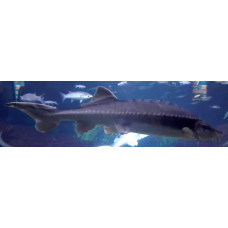Latin name
Huso huso
Other names
Beluga, beluga sturgeon
Identification
Has typical characteristics of other sturgeons, such as an elongated body, a heterocercal tail, a partially cartilaginous skeleton, bare skin and a longitudinal row of shields. The gill membranes of the great sturgeon are fused and form a loose fold under the gill space. The snout is short, pointed, soft at the top and sides, and has no plates. The mouth is large, semilunar. Lower lip interrupted. The rostrum is conical and contains numerous sensory fossae on both the ventral and dorsal surfaces. The antennae are flattened on the sides and have leaf-like appendages. The first dorsal fin has 62-73 rays; anal fin 28-41; dorsal bugs 11-14, lateral bugs 41-52, ventral bugs 9-11; gill stamens 24. The first dorsal beetle is the smallest. Between the beetles the body is covered with bone granules. Dorsum dull grey-brown, abdomen pale.
Distribution
A passing fish found in the Caspian, Azov and Black Seas, from where it migrates to rivers to spawn. It was relatively common until the early 20th century, but is now threatened with extinction in the wild.
Habitat
Passing fish. It has a benthic-pelagic lifestyle. Occurs in a wide range of salinity (‰): in the Caspian Sea - 12-13, Black Sea - 17-18, Mediterranean Sea - about 35.
Size
One of the largest freshwater fish, reaching a weight of one and a half tonnes and a length of 4.2 metres. A long-lived fish, it can live to be 100 years old.
Life history and Behavior
Leads an anadromous lifestyle, migrating upstream to spawn on clean, hard substrate that provides both support and shelter for their sticky eggs.
Food and feeding habits
A predator that feeds mainly on fish. It begins to hunt as a juvenile in the river. In the sea it feeds mainly on fish (сlupea, сlupeonella, gobiidae, etc.), but does not neglect molluscs. Even baby seals have been found in its stomach. As an adult it eats other sturgeons of smaller size. As a rule, sturgeon do not feed on other sturgeon.
Reproduction
Can spawn many times in a lifetime. After spawning it rolls back to the sea. Eggs are bottom dwelling, sticky. Fecundity, depending on the size of the female, ranges from 500,000 to one million (in exceptional cases up to 5 million) eggs. Males reach sexual maturity at 12-16 years, females at 16-22 years. They lay eggs every four to seven years. The female lays her eggs on gravel at a depth of 4 to 40 metres (13 to 11 feet) underwater. After hatching, the embryos reach a length of 11 to 14 mm (0.43 to 0.55 inches) and after 10 to 14 days, when they hatch, the yolk sac is 18 to 20 mm (0.71 to 0.79 inches) long. After this, the larvae usually feed on benthic invertebrates, but when they reach at least 10 cm in length, they switch to a fish diet. Young sturgeon can swim up to 60 kilometres (37 miles) a day on their way back to the sea.
Interesting facts
Giant fish are not only found in the ocean. Take the Caspian Sea, for example. Everyone knows the Caspian great sturgeon. After sharks and giant rays, it is the largest fish. In 1926, a great sturgeon weighing 1,228 kilograms was caught, and it contained 246 kilograms of caviar. In 1827, a Great sturgeon weighing 1,440 kilograms was caught — the largest fish ever caught.
Interesting Facts
Some researchers believe that certain fish, like the Great sturgeon, might use echolocation. This means they make sounds and listen for the echoes bouncing off the riverbed or other objects. It's not proven yet, but it is a fact that some fish have a different kind of "radar" that uses electric fields instead of sound.
| Classification | |
| Phylum | Chordata |
| Class | Actinopterygii |
| Squad | Acipenseriformes |
| Family | Acipenseridae |
| Genus | Huso |
| Species | H. huso |
| Features | |
| Conservation status | Critically Endangered |
| Habitat | Pelagic |
| Life span, years | 100 |
| Maximum body weight, kg | 15000 |
| Maximum length, cm | 4200 |
| Sailing speed, m/s | No information |
| Threat to people | Edible |
| Way of eating | Predator |
Great sturgeon
Tags: great sturgeon



